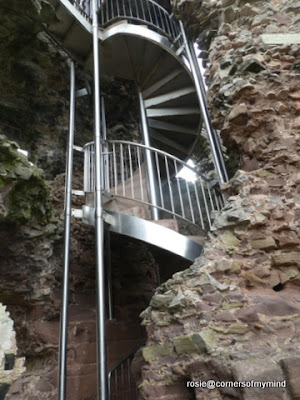We were based in Rhuddlan so could walk out in the evenings from our hotel to the small nature reserve across the road. There was a lovely view from there across the fields to the castle which you can also see as you drive into the small town.
We walked into the town a few times over the footbridge across the River Clwyd.
The parish church of St Mary taken from the footbridge. We didn't walk up there but it looks an interesting church.
View of the castle from the footbridge, We walked up to the castle from the town centre.
The impressive West gatehouse which was a show of strength and power. The castle was one of the first commissioned by Edward I following the first Welsh war. The building work was overseen by master mason James of St George. Completed in 1282 it cost around £9,000 which must have been millions in those days.
The castle withstood many attacks from the outside world including during the Welsh rising in 1294 and from Owain Glyndwr in 1400. It was finally breached by Parliamentarian troops in 1646 at the height of the civil war. It was partially demolished in 1648 to prevent further use.
The castle has a unique diamond shaped layout and is protected on three sides by the moat and by the river on the fourth side.
The stairs lead up to the top of the East gatehouse. Paul went up to the top, I stayed firmly at ground level.
The information board (a bit faded by sun the sun) shows how the moat was accessed from the river. The River Clywd was diverted and canalised for a distance of two miles so that it would flow by the castle and the town.
It meant that goods and supplies could be brought up the river from the sea. Gillot's Tower (above) was a lookout tower and protected ships dropping off goods at the dock.
Before we went into the stone castle we walked a short distance to find an earlier motte and baily castle.
In 1063 Rhuddlan was the royal seat of Gruffydd ap Llywelyn who was forced to flee there by King Harold I the last Saxon king before he was killed, three years later, at the Battle of Hastings. It was at the orders of the new King William I (the Conquerer) that the motte and bailey castle was built c.1073 by Robert of Rhuddlan, a former squire at the court of Edward the Confessor. The new castle was built on or near the site of Gruffydd ap Llywelyn's palace.















You seemed to have picked the perfect spot to stay for your holiday. Thank you for your brief history and information about Rhuddlan Castle, it is always interesting to read about where you have been.
ReplyDeleteWe were well placed to leave the car and walk within the town and just a quick journey to St Asaph or the other way to the coast:)
DeleteWonderful photos, and fascinating history. How many workers must it have taken to build such a massive place?
ReplyDeleteSome workers would have spent a lifetime working on a project and never see it completed especially those working on castles and cathedrals. Same as those later workers constructing canals and then railways. I find it fascinating:)
DeleteWhat an impressive place. I really enjoyed the photos and all the information and that sculpture at the end. We're so lucky to have so much history to explore in this country. 😊
ReplyDeleteThank you, the castle stands high above the town, the sculpture stands just at the end of the footbridge into the town:)
DeleteWhat a super castle and such interesting history. Great photos Rosie and interesting to note how many castles were attacked and put out of commission in the Civil War. Love the motte and bailey too. Looks like you picked a great place to stay with the nature reserve too.
ReplyDeleteLook forward to the bluebells and have a good weekend.
Rhuddlan was a perfect place to stay, in walking distance from the hotel were the nature reserve, castle and motte and bailey castle too Also a lovely tea shop for afternoon tea:)
DeleteA fascinating castle!
ReplyDeleteIt was a good place to visit:)
DeleteWhat a lovely place to stay. I once excavated a motte and Bailey castle in Norfolk. Such fascinating history these place have. B x
ReplyDeleteYour excavation sounds fascinating, what a great experience:)
DeleteA castle with a very long & fascinating history in such a beautiful setting. Thanks for sharing & look forward to the bluebells. Take care & hugs.
ReplyDeleteThree different castles or residences on the same site. Bluebells were gorgeous, post over the weekend, take care:)
DeleteA fascinating place to wander around. I've found that it's not a good idea to point out to Welsh people that almost all of "their castles" are in fact built by the English!
ReplyDeleteOh dear, perhaps not. We met a wonderful historian at Denbigh castle full of enthusiasm for the place. Both castles were fascinating:)
DeleteMessage for Bethany - I've lost your e-mail (plus others) but I remembered your name and that you had a query re something at a castle or museum. If you read this leave me a message here as my e-mail is compromised at the moment:)
ReplyDelete